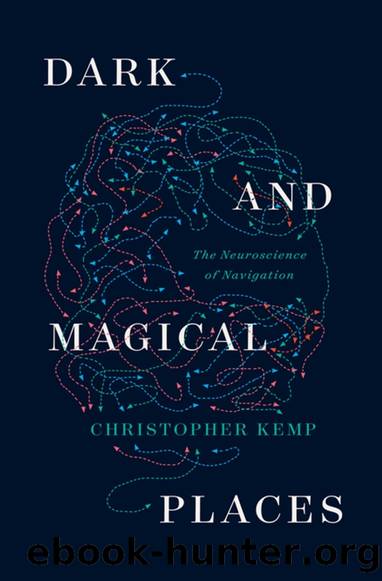Dark and Magical Places: The Neuroscience of Navigation by Christopher Kemp

Author:Christopher Kemp [Kemp, Christopher]
Language: eng
Format: epub
ISBN: 9781324064381
Google: 2pNozwEACAAJ
Amazon: 1324005386
Barnesnoble: 1324005386
Goodreads: 58085260
Publisher: Profile Books
Published: 2021-11-15T06:00:00+00:00
Unlike the Siberians, I am not able to do this to any degree at all. Von Wrangell would have watched me with dismay. I can navigate neither hummocky ice nor my own neighborhood, which bristles with familiar landmarks.
Elizabeth Chrastil (a 9 out of 10) is standing in an empty, low-ceilinged room on the campus of the University of California, Irvine in the Center for the Neurobiology of Learning and Memory. In fact, itâs not even a room: itâs a portable classroom trailer, a room that can move, not unlike the rooms of my own house when I try to imagine them in my mind. It sits approximately forty miles southeast of the concrete freeway sprawl of downtown Los Angeles. The skylights and windows have been blacked out, and the walls are unadorned and painted a nondescript grey colorâapproximately, Pantone Cool Gray 6C. The carpet is an institutional pistachio green. At the moment, in the center of the room, one of Chrastilâs subjects pulls a sturdy black pair of virtual reality goggles over her head. Tucking in her disobedient hair, she straightens and then lifts her foot and takes a tentative step forwardâinto the void.
Chrastil is leading her subject through a virtual path integration test. Outside the trailer, beyond its thin walls, the campus bustles with activity as students head from lecture halls and laboratories to the science library and bagel shops. But inside the trailer, the subject is navigating a featureless pixelated desert.
âA lot of people are really excited to do virtual reality tasks,â says Chrastil. But then they land in the virtual desert. Itâs not fun. Itâs like Tron. âItâs actually really kind of boring,â she says. Even so, to Chrastil the featurelessness of the virtual desert is an important tool: itâs an empty environment. âWe want to reduce the number of cues and landmark information that are out there in the world,â says Chrastil. We rely heavily on landmarks when we navigate, and there are brain structures solely dedicated to detecting them. But landmarks wonât help Chrastil understand path integration.
âThey can be very useful for navigating,â she says, âbut they might not force you to rely on path integration.â
This is not an abstract idea. It has concrete real-world utility. Imagine youâre staying in an unfamiliar city: early in the morning, you leave your hotel and step onto the sidewalk, into the shadows of the canyon formed by two facing walls of skyscrapers. Itâs a place the sunlight never quite reaches, like underwater depths far beneath the surface chop. You are in search of coffee. You turn left, walk to an intersection that belongs to a gang of scruffy pigeons, and then take a right, where you pass a pharmacy, a shoe store, and a watch repairer, before turning left again, onto a wide avenue lined with brand-name stores. Nike. Apple. Gap. Tiffany & Co. And then finally: a coffee shop, sandwiched between dark and shuttered designer stores.
By this time, if you are like me, you are hopelessly lost.
Download
This site does not store any files on its server. We only index and link to content provided by other sites. Please contact the content providers to delete copyright contents if any and email us, we'll remove relevant links or contents immediately.
| Cell Biology | Developmental Biology |
| Entomology | Marine Biology |
| Microbiology | Molecular Biology |
| Biostatistics |
Sapiens: A Brief History of Humankind by Yuval Noah Harari(14244)
The Tidewater Tales by John Barth(12608)
Mastermind: How to Think Like Sherlock Holmes by Maria Konnikova(7222)
Do No Harm Stories of Life, Death and Brain Surgery by Henry Marsh(6887)
The Thirst by Nesbo Jo(6826)
Why We Sleep: Unlocking the Power of Sleep and Dreams by Matthew Walker(6618)
Life 3.0: Being Human in the Age of Artificial Intelligence by Tegmark Max(5474)
Sapiens by Yuval Noah Harari(5293)
The Longevity Diet by Valter Longo(5017)
The Body: A Guide for Occupants by Bill Bryson(4973)
The Rules Do Not Apply by Ariel Levy(4842)
The Immortal Life of Henrietta Lacks by Rebecca Skloot(4523)
Animal Frequency by Melissa Alvarez(4394)
Why We Sleep by Matthew Walker(4358)
The Hacking of the American Mind by Robert H. Lustig(4318)
Yoga Anatomy by Kaminoff Leslie(4303)
All Creatures Great and Small by James Herriot(4229)
Double Down (Diary of a Wimpy Kid Book 11) by Jeff Kinney(4204)
Barron's AP Biology by Goldberg M.S. Deborah T(4095)
